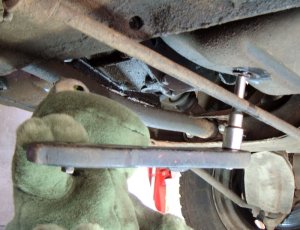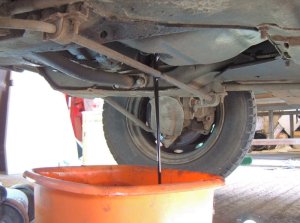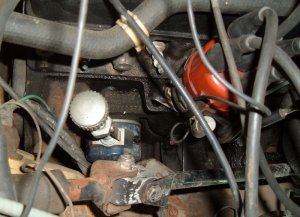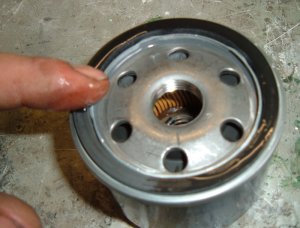How to do an Oil Change
Frederick the Frog demonstrates how to do an oil change. The page is aimed at Renault 4 owners, but should apply to some extent to most classic cars. Frederick has also written a page showing what happens if you don't change your oil.
You'll need a couple of tools to change the oil in a Renault 4.
The first is an oil filter strap wrench for gripping and removing the oil filter (they are too tight to remove by hand). The second is a 10mm square ended tool (mine is a crudely modified socket set extension).
It's worth having a few rags to hand. Wearing latex gloves could also be an idea.
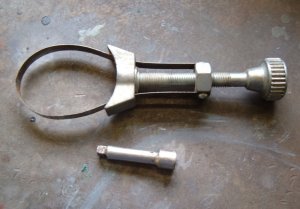
Warm the engine up for a few minutes before changing the oil. This makes the oil thinner, so less of the old oil will remain inside the engine. Don't get the oil too hot - you might burn yourself.
Then clean the area around the drain plug with a rag and loosen the plug. Place the oil catching container underneath the car and remove the plug by hand.
I drain the oil into an old plastic washing up bowl, and then use a funnel to transfer the oil into an oil container. There are special oil draining containers, but I've never had success with them.
It helps to undo the oil filler cap to allow air into the engine and help the old oil to drain out.
The oil filter should ideally be replaced at the same time as the oil is changed.
The oil filter is located on the right side of the engine behind the distributor. It's quite inaccessible, hence the need for an oil filter strap.
The filter will empty it's contents of oil when it is removed. Position the bowl underneath the car to catch the oil.
Renault changed the thread on the filter in 1984, so the filters before and after that date are not interchangeable. For pre-'84 use FRAM PH 2874 and post-'84 (bigger thread) use FRAM PH 5796. It should be possible to cross-reference the numbers with other manufacturers.
Smear some new oil onto the rubber seal to make the new oil filter easier to fit, then fit the new filter by hand (not using the strap wrench). Make sure the sealing face is clean.
Finally, clean and refit the sump plug and fill the engine with new oil.
Filling with new oil
The Renault 4 oil capacity is about 3 liters. Fill the engine until the level reaches the maximum mark on the dipstick. Then run the engine for a minute. Let the engine stand (to allow the oil to drain back to the sump), and top up the oil if necessary. This allows the oil filter to fill with oil.
Finally check the sump plug and oil filter for leaks. If the filter leaks it either has dirt under the mounting or isn't tight enough. If the drain plug leaks then probably the copper sealing ring needs to be replaced.
Oil Change Intervals
The Renault handbook suggests changing the oil every 5,000 miles, and the oil filter every 10,000 miles. This seems reasonably sensible advice, although I normally change the filter with every oil change. They aren't expensive. Neglecting oil changes can lead to oil sludge and a scrap engine.
Which oil to use?
Back in the days when Renault 4s were built the only oil available was 20/50. That oil is still available, and is available from motor factors for less than £5 per gallon. That's cheaper than petrol!
Modern cars are built to extremely tight tolerances and use thin oil. This could cause the Renault 4 engine to run at a lower oil pressure, which could be an issue for an older engine.
Disposing of waste oil
Waste oil is nasty stuff (that's why we can't have scrap yards any more). In the UK the local tip will normally have a container for waste engine oil. Don't pour it down the drain! It's illegal, will kill the fishies and also block the drain.
Back to Tech Tips



Engine
Electrical
Suspension
Front suspension lower balljoint
Brakes and hubs
Other
Frederick's angle grinder (RIP)

